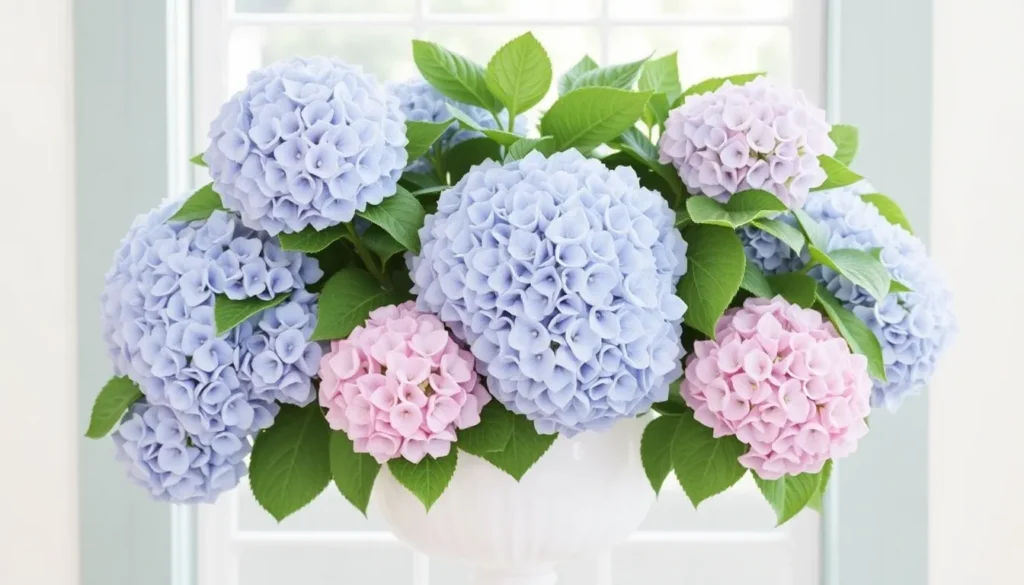Designing with Hydrangeas

When it comes to designing landscapes, few plants can match the beauty and versatility of hydrangeas. These stunning shrubs not only provide vibrant blooms but also enhance the overall aesthetic of gardens, making them a favorite among landscape designers and gardening enthusiasts alike. In this article, we will explore the various aspects of hydrangeas, their uses in floral design, and tips for creating breathtaking arrangements.
What pairs well with hydrangeas?
Hydrangeas are incredibly versatile and can be paired with a variety of plants to create beautiful garden compositions. Their lush foliage and striking flowers harmonize with many other species, allowing for diverse combinations that enhance the overall visual appeal of a landscape.
- Perennials: Plants like coneflowers and daylilies complement hydrangeas well, adding texture and color contrasts.
- Grasses: Ornamental grasses, such as Miscanthus or Panicum, provide a lovely backdrop and movement against the hydrangeas' static blooms.
- Evergreens: Incorporating evergreen shrubs can add year-round structure and balance to the garden design.
- Annuals: Bright, flowering annuals can be interspersed for an immediate pop of color and seasonal diversity.
- Foliage plants: Plants with striking foliage, like hostas or ferns, can add interest alongside the bold blooms of hydrangeas.
By carefully selecting companion plants, gardeners can create multi-dimensional landscapes that showcase the unique beauty of hydrangeas while ensuring a cohesive design.
Uses of hydrangeas in floral design
In floral design, hydrangeas are prized for their lush, voluminous blooms and long-lasting nature. They serve multiple purposes, making them a staple in various arrangements.
- Bouquets: Their large flower heads make a stunning focal point in mixed bouquets, providing fullness and texture.
- Centerpieces: Hydrangeas can dominate centerpieces, offering a sophisticated look for weddings and events.
- Floral arrangements: They blend beautifully with other flowers, enhancing color palettes and creating rich, layered designs.
- Dried arrangements: Once dried, hydrangeas maintain their form and can be used in long-lasting arrangements, adding depth and interest to decor.
- Seasonal displays: Their blooms can signify different seasons, as they transition from vibrant blues and pinks to deeper hues in the fall.
Whether used in formal arrangements or casual bouquets, hydrangeas provide versatility and elegance, making them a favorite among florists and event planners.
The growth characteristics of limelight hydrangeas
Limelight hydrangeas, known for their unique greenish-white blooms, are a stunning addition to any garden. Understanding their growth habits is essential for effective planting and care.
Typically, limelight hydrangeas can grow to a height of 6-8 feet, with a similar spread. They thrive in full sun to partial shade and prefer well-drained, moist soil. With proper care, these shrubs can become a magnificent focal point in your garden.
Creating multi-colored hydrangeas
One of the fascinating aspects of hydrangeas is their ability to change color based on soil pH. This unique trait allows gardeners to create stunning multi-colored displays. Here are some tips:
- Soil pH: Acidic soils (pH below 6) can produce blue blooms, while alkaline soils (pH above 7) tend to yield pink flowers.
- Aluminum sulfate: Adding aluminum sulfate to the soil can enhance blue hues by increasing the availability of aluminum to the plant.
- Lime: Applying lime can alter the soil pH to more alkaline, producing lovely pink flowers.
- Mixing varieties: Planting different cultivars with varying colors can also create a vibrant, mixed border.
By experimenting with soil amendments and plant combinations, gardeners can enjoy a stunning array of colors throughout the blooming season.
Maintenance tips for hydrangeas
Caring for hydrangeas is relatively straightforward, making them suitable for both novice and experienced gardeners. Here are some essential maintenance tips:
- Watering: Hydrangeas require consistent moisture, especially during hot summer months. Ensure they receive enough water to prevent wilting.
- Fertilization: A balanced fertilizer in early spring can encourage healthy growth and vibrant blooms.
- Pruning: Prune in late winter to early spring to promote new growth, but be cautious not to cut too much, as this can reduce flowering.
- Mulching: Apply mulch to retain soil moisture and suppress weeds, helping your hydrangeas thrive.
- Pest management: Regularly check for pests such as aphids or spider mites and address any infestations promptly.
By following these simple care guidelines, you can ensure that your hydrangeas remain healthy and produce stunning blooms year after year.
For those looking for visual inspiration and practical tips on hydrangea care, consider watching this informative video:
Designing with hydrangeas in your garden
Incorporating hydrangeas into your landscape design can create stunning visual impacts. They work well as focal points, borders, or backdrops, depending on the style of the garden.
- Focal points: Use large hydrangea varieties to create a dramatic central feature in your garden.
- Layering: Combine hydrangeas with taller plants behind and shorter perennials in front for a tiered effect.
- Mass plantings: Grouping multiple plants together can create a lush, cohesive look that draws the eye.
- Seasonal interest: Plan for a mix of bloom times to ensure color and texture throughout the growing season.
- Contrast: Pair hydrangeas with contrasting foliage or flowers to enhance their beauty.
By thoughtfully considering the placement and combination of hydrangeas with other plants, you can design a garden that is both beautiful and functional.
Final thoughts on hydrangeas
Hydrangeas offer a wealth of possibilities for gardeners and designers alike. From their stunning blooms to their adaptability in various environments, these shrubs can enhance any landscape. Whether you're planting in a small garden or creating an expansive floral display, hydrangeas are sure to be a cherished addition. Their striking visual appeal, combined with their relatively low maintenance needs, make them a go-to choice for many gardening enthusiasts.
 Guide to Wiring a 3-Way Light Switch
Guide to Wiring a 3-Way Light Switch How to Choose the Right Professional for Popcorn Ceiling Removal
How to Choose the Right Professional for Popcorn Ceiling Removal Top family vacation spots to visit in 2025
Top family vacation spots to visit in 2025 Barbra Streisand's fabulous houses reflect her iconic style
Barbra Streisand's fabulous houses reflect her iconic style Stylish Pembrokeshire getaway: beautiful interiors and nature
Stylish Pembrokeshire getaway: beautiful interiors and natureIf you want to know more about similar articles like Designing with Hydrangeas you can visit category Landscaping.
Deja una respuesta